#not even a character. just a concept with a design. an apparition made to teach humans a lesson
Text
i think people's takes on jev being this like thousand year old creatura are fascinating and fit even my interpretation of his character and place in the story (as like. a representation of the setting at large. an archaic force being shoved into a simulation/loop/machine. cosmis horror kinda shit) but i also think it's 1. funnier 2. scarier 3. more emotionally scarring to imagine him as like. a 30, 40, 50 year old man. just a quirky little guy. he had a childhood, maybe he got picked up by seam as an urchin and they were a travelling magic act and clownery and judy n punch duo and they stole apples from the market and he climbed trees w his little paws before someone made him wear shoes. he was a brash teenager and he played the accordion and kept all of his trinkets in a little chest he used to sleep in. seam made his suits, from his own crayon drawings. he was a middle aged man disenchanted with his work and he sought shelter from the boredom in bothering others. and he ran away so many times and he slept outside and he helped seam make their own beer and mead and they still played the accordion and the hurdy-gurdy together. isn't it scarier to make him a normal man? who turns into what we see? doesn't that hurt more doesn't that make his character even deeper. he was just like you and this means That can happen to you too, grounding stuff like that is like one of the basic rules of horror. and then he just goes to jail they straight up lock a mentally ill guy with all those horrors in the basement - not an old-as-time-itself demon, not a savage beast, but. a man. jevil russian sleep experiment au.
again im not calling anyone out its just an interpretation ive NEVER seen anyone else come up with and i genuinely wonder why and if my other jev readings continue to be weird as fuck to other people
#jevil#its kinda like. a reverse dc joker situation. the jerker does get like. INSIDIOUSLY scary and mind-fucky when#you turn him into. i wouldn't say satan himself that takes the edge off. but something completely unknown.#im casually writing a batman script in my own continuity and i could never keep up w All The Lore cuz thats not what batman is abt to me#and i took most of my inspiration from a serious house on serious earth and. those intermission strips in snyder's endgame#where people from an asylum or a nursing home i can't quite remember that had encounters w joker#describe him as all sorts of things but not human. and not in like oh he's a monster but like That Is Not A Homo Sapiens#and they're not listened to because they were all suffering from delusions and hallucinations before that but#yea. i hate jerker origin stories i hate them with my whole entire heart. make him the unknowable. not even a demon not satan#nothing of folklore or religion not even a lovecraftian something-something. just an entity. maybe not even an entity. he's an scp to me#not even a character. just a concept with a design. an apparition made to teach humans a lesson#you dont know how he got here you dont know why you wont ever know when he'll be gone.#give me judge holden but even more amorphous and. not scarring me for life. but u get the idea#im tryyyiinnnggg to write joker like an apparition of a schizo psyche like my dreams.#my favorite song to 'write' j to is freefall by rainbow kitten surprise. and he's just a figment of bruce's imagination here#just a little more tangible. vague and wrong but it's j. probably. and it's bruce's pov. it's a couple lines of dialogue#that's j. jevil is the opposite.
13 notes
·
View notes
Text
Samurai references in One Piece
Even when this is "short" this took me a long time to made but I finally finished it. I know that maybe I do not have ALL the references, but I'll mention the ones I've been seeing since I'm watching One Piece again. Also you'll read a lot about Zoro because he seems to be the character in which Eiichiro Oda likes to represent these warriors. I couldn't avoid pointing them out, especially since we're actually in Wano, to show you all a little of the influence they have in One Piece (at least in this arc.. or just in Zoro...). Of course there'll be manga spoilers.
1. The breath of all things.

While Zoro and Daz Bones were fighting in Arabasta, Zoro sees that he is at a disadvantage against his rival because this one is the user of the Devil fruit of steel, and that is a material that he wasn't capable of cutting. After a few attempts, he remembers a particular moment from his childhood about one of the lessons that his teacher and Kuina's father, Koshiro, teach him after a young Zoro asks if it is possible to cut steel. Koshiro gives him a demonstration when he tries to cut a piece of paper with his sword, but fails. After receiving a confused look from his student, he says what is in the pic beneath.
This teaching is inspired by one of the legends of Masamune Ozaki. In this story, Masamune (Who was not a samurai but a blacksmith who still was closely related to them) is challenged by his disciple Muramasa Shinji to see who of the 2 is the best blacksmith in Japan. Masamune accepted the challenge and after days of dedication and effort he created Yawarakai Te (Soft Hands / 柔らかい手). Muramasa also worked tirelessly and, finally, shaped Juuchi Yosamu (10,000 cold nights / 十千夜寒).
To test the value of each of them, Masamune and Muramasa were summoned on the riverbank one day at dawn. Once there, Muramasa submerged the first the tip of his sword in the water, against the current. Juuchi Yosamu, the Muramasa blade, cut everything that came close to its edge: it split the leaves that floated in the river and cut in half the fish that swam nearby. It even cut the morning air and the same sunlight. Masamune recognized with a deep reverence the great work of his disciple Muramasa. Indeed: there could not exist in all of Japan a sharper blade than that blade and only a Grand Master could make a sword like Juuchi Yosamu. But now his turn had come. He closed his eyes for a few moments and unsheathed Yawarakai Te. The brightness of the soft forging of his blade was reflected on the water while the old blacksmith dipped the tip of his sword into the river. And, then ...
Nothing happened because the fish that came close to Masamune's sword swam peacefully around him, without getting hurt. The leaves that floated down the river collided with it, turned on themselves and followed their course where the current led without splitting or cutting. Sunlight shone on the sword and the wind whistled softly as it struck its edge. Muramasa began to laugh at his master's sword. "You are no longer able to make a sword that really cuts. Now the best blacksmith in Japan is me" he said. Masamune did not answer. He drew his sword from the water and, still smiling, dried it first and then put it in its holster.
An old monk who had seen everything from the other shore said:
"There is a sword that is very well made, that is very beautiful and sharp, but is eager to cut and does not discriminate against who or whom. But the other sword is undoubtedly more beautiful and more perfect because its edge is still finer and does not need to cut what is innocent and does not deserve to be cut. There is a sword that takes away life and another sword that gives it. "
Note: Of course this is only a legend since Masamune Ozaki and Muramasa Shinji are many years apart (almost 100 I suppose), so I understand they did not even know each other, but you get the point.
2. The Kitetsu.

The kitetsu are a "trio" of Yōtō ( cursed swords / 妖刀) that are said to bring misfortunes to their owners until they find death in horrible ways. They are demonic swords whose thirst for blood is insatiable and whose edge and ease to cut things are incredible, almost incomparable.
Now, this is related to one of the aforementioned blacksmiths, specifically with his clan, the Muramasa. Muramasa Shinji was a person of unstable and violent character, it was said that his swords leaves, shorter, more curved and more affiliated than those of Masamune, instilled in the warriors that carried them an uncontrollable desire to kill.
But the swords of Muramasa fell into disgrace when Tokugawa Ieyasu arrived at the shogunate, at the beginning of the 17th century, due to the many misfortunes that these swords caused to his family: the Kaishaku (end of the seppuku ritual in which the assistant beheads the suicidal with a katana) of Ieyasu's son, Nobuyasu, was made with a Muramasa; in his childhood, Ieyasu was wounded with a Tantō Muramasa; Ieyasu's grandfather was killed with a Muramasa katana; Ieyasu's father was attacked with a wakizashi Muramasa. Therefore, the shogun banned the use of Muramasa clan weapons in Japan. Even the Bugyō (commissioner / 奉行) Nagasaki, who was a collector of Muramasa weapons despite the ban, was executed under direct orders from the Shōgun (army commander/ 将軍) Tokugawa Ieyasu for considering this as an obvious conspiracy against his clan.
For all this, they said, Muramasa's katanas brought their owners misfortunes and unnecessary deaths, while those of Masamune were only unsheathed when the situation inevitably required it.
3. Taken from movies.
Maybe some of you already know it, but I do not lose anything mentioning it. Issho (or Fujitora) is based on Zatōichi (座頭市), the protagonist of a television series and a large number of films about a blind, but very skilled swordsman.
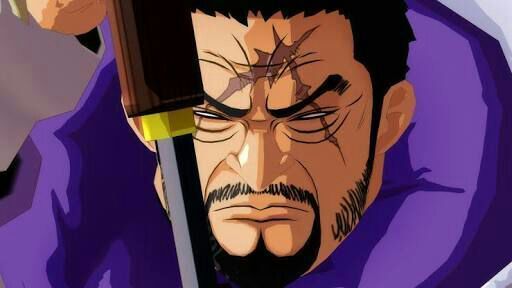
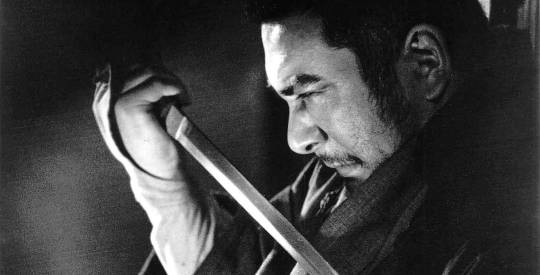
Literally is the same thing without scars, they even have the same sword...
However, the designs are not the only thing that Oda has been inspired to add to his work. There are a number of thoughts/quotes that he has also taken from different movies like this one, that he says is one of his favorites, called Shichinin no samurai (The Seven Samurais/ 七人の侍).
I won't make much spoilers. In one scene of the film, while the protagonists are looking for another samurai to join them, they hear that one has arrived at the town. To test if he's worth of joining them, one of them hides to the side of the door to ambush him, saying: "If he is a true swordsman he will be able to dodge it, a samurai never lets alcohol take control on himself". Does it remind you of something?
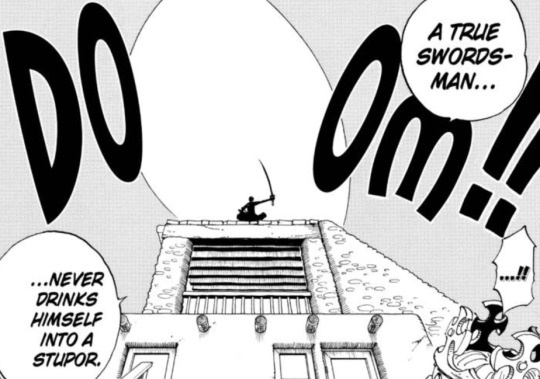
4. Roronoa Zoro's "true" inspiration.
Even though we all know Zoro is based on François l'Olonnais, who was the cruelest pirate of the Caribbean Sea; I can say that he is also a little based on Date Masamune.
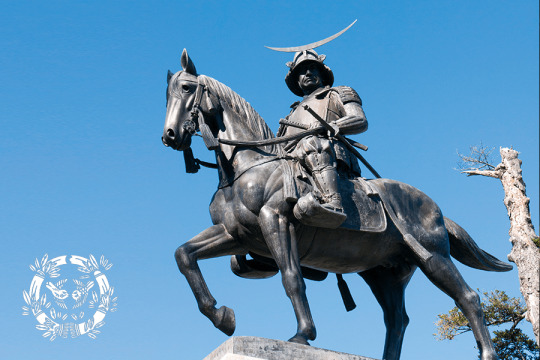
Excellent military tactician, was popularly identified because of the lack of one of his eyes, commonly being called "dokuganryū" (Dragon of a single eye/ 独眼 竜).
The exact cause for which he lost his entire eye is not known, but it is said that as a child he lost it because of smallpox and to save himself he took it off. After this, his mother told him he could never become a warrior, explaining to Masamune's father that having just one eye already put him in an abyssal disadvantage on the battlefield. Because of that, he swore he would never let anything else get over him, not even something like an illness.
At the young age of 17 or 18 years old, he took his father's place as the leader of Date's clan; later becoming one of the most powerful Daimyō (大名) of the old Japan.
This fiery samurai was also known because of his cruelty and cold personality. Not caring who he was talking to, he'd always be a prepotent and shameless man who gained the respect, but mostly fear, of those who were around him.
5. Pirate hunter's journey.
As we all know, in the begining of the serie when Luffy asked Zoro why he sailed, the swordsman told him he was looking for someone (Dracule Mihawk) but then got lost. Sailing to the sea to find recognition and become the greatest swordsman, as he promised to Kuina, sounds like certain practice called Musha shugyō (warrior training/ 武 者 修行) that's based on traveling or pilgrimage to which the ancient samurai were ascribed. A practitioner of this concept has to roam around Japan practicing and honoring his abilities without the protection of his family or his school, all alone and exposing himself to the dangers necessary to prove his worth. The possible activities of the adventurer could include training with other schools, fighting a duel, working as a bodyguard/mercenary, and looking for a Daimyō to serve.
Soooo he found a "Daimyō" to live and to die for.

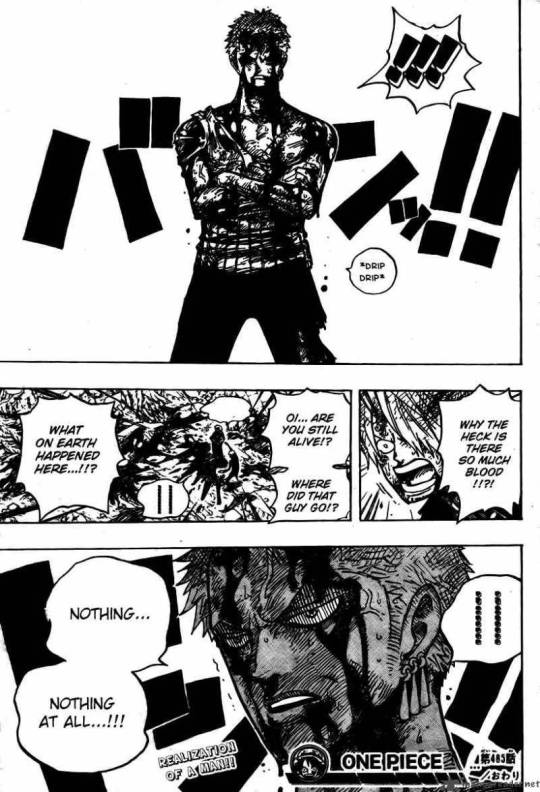
Note: I'm not saying Zoro is a samurai, in fact and sadly, he isn't. I repeat, I'm just pointing things that I can relate to them.
6. Kaidan.
Kaidan (怪談) is a Japanese word consisting of two kanji: 怪 (kai) meaning “strange, mysterious, rare, or bewitching apparition" and 談 (dan) meaning “talk” or “recited narrative.”In its broadest sense, kaidan refers to any ghost story or horror story, but it has an old-fashioned ring to it that carries the connotation of Edo period Japanese folktales. Kaidan entered the vernacular during the Edo period, when a game called Hyakumonogatari Kaidankai (A Gathering of One Hundred Supernatural Tales / 百物語怪談会 ) became popular. This game led to a demand for ghost stories and folktales to be gathered from all parts of Japan and China.
Originally based on didactic Buddhist tales, Kaidan often involve elements of karma, and especially ghostly vengeance for misdeeds. Onryō (Japanese vengeful ghosts / 怨霊) are far more powerful after death than they were in life, and are often people who were particularly powerless in life, such as women and servants. You all know who were servants? There's certain transtalion or meaning to samurai that says "those who serve in close attendance to the nobility"; Not only that, since Kaidan appeared in Edo period these warriors are the co-protagonists of many of those stories. If we look up at some of those stories we can conclude something; at least two of them are the "inspiration" to certain samurais in Wano and they are Kin'emon and O-kiku.
We need to be clear on something, they are considered ghosts by the people of Wano that seek to avenge Oden's death so thinking that Oda made this on purpose is pretty logic, right?
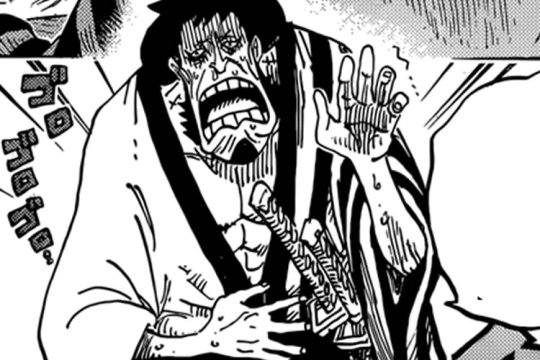
Lets start with Kin'emon. He's, at least a bit, inspired in Botan Dōrō (The Peony Lantern / 牡丹燈籠)
This tale tells that on the first night of Obon, a beautiful woman and a young girl holding a peony lantern stroll by the house of the widowed samurai Ogiwara Shinnojo. Ogiwara is instantly smitten with the woman, named Otsuyu and vows an eternal relationship. From that night onward, the woman and the girl visit at dusk, always leaving before dawn. An elderly neighbor, suspicious of the girl, peeks into his home and finds Ogiwara in bed with a skeleton. Consulting a Buddhist priest, Ogiwara finds that he is in danger unless he can resist the woman, and he places a protection charm on his house. The woman is then unable to enter his house, but calls him from outside. Finally, unable to resist, Ogiwara goes out to greet her, and is led back to her house, a grave in a temple. In the morning, Ogiwara's dead body is found entwined with the woman's skeleton.
Why I relate Kin'emon with this story? To be honest it reminded me of him for dumb reasons ;;; The woman's name sounds like Kin'emon's wife's name, O-tsuru. Also I have the feeling that he won't be able to resist any longer being apart with his wife, wich he seems to love very much. Or not necessarilly because he wants to be with her but to warn her to run away at some point and someone will notice and bla bla bla.

Now, O-kiku is inspired by the history of Banchō Sarayashiki (The Dish Mansion at Banchō / 番町皿屋敷 ) that tells that once there was a beautiful servant named Okiku. She worked for the samurai Aoyama Tessan. Okiku often refused his amorous advances, so he tricked her into believing that she had carelessly lost one of the family's ten precious delft plates. Such a crime would normally result in her death. In a frenzy, she counted and recounted the nine plates many times. However, she could not find the tenth and went to Aoyama in guilty tears. The samurai offered to overlook the matter if she finally became his lover, but again she refused. Enraged, Aoyama threw her down a well to her death.
It is said that Okiku became an Onryō who tormented her murderer by counting to nine and then making a terrible shriek to represent the missing tenth plate – or perhaps she had tormented herself and was still trying to find the tenth plate but cried out in agony when she never could. In some versions of the story, this torment continued until an exorcist or neighbor shouted "ten" in a loud voice at the end of her count. Her ghost, finally relieved that someone had found the plate for her, haunted the samurai no more.
In some versions of the tale, Okiku is a maid who incurs her mistress' jealousy. Her mistress breaks one of dishes that Okiku is responsible for and Okiku commits suicide. Similar to the other versions, her ghost is heard counting the plates, but her mistress goes insane and dies.
Did you notice the same name, that in her first apparition she is holding a plate and that she refuses someone who's looking for her to be his lover? Hmmm.
7. Extras.
These are just mentions so I'll compilate them here.
⦁ Zoro's name in Wano is Zorojuro, which sounds a lot like Sanjuro, the name of the protagonist from another samurai movie called Yojimbo (which probably Zoro got his personality from); casually made by the same director from The seven samurais, and a lot more movies about these warriors, Akira Kurosawa.
⦁ It's possible that Shuusui is based on, it is said to be, the best sword ever made by Masamune Ozaki, called Honjo Masamune. I think this sword was "stolen" and is still lost.
⦁ Zoro's way of seeing the world is absolutely based on Miyamoto Musashi's lessons writen on his book Go Rin no Sho (The Book of Five Rings/ 五輪書). Not only that, Musashi felt that he won his duels not because he had mastered the strategy, but because he was stronger, prepared or just lucky... we all know Zoro likes to leave all to luck.
⦁ Vivi calls Zoro "mr. Bushido". Bushidō (武士道) is a strict and particular ethical code to which many samurai gave their lives, which demanded loyalty and honor until death. If a samurai failed to maintain his honor, he could recover it by practicing seppuku.
⦁ O-Tama saying that is a disgrace for a warrior to feel hunger is also said in The Seven Samurais.
⦁ The Gorōsei (The Five Elders / 五老星) the leaders of the World Government and, as such, the world's rulers and the highest authority only below Im, are based on The Council of the Five Regents, or council of the five great elders (go-tairō / 五大老). This was a council formed by Toyotomi Hideyoshi to govern Japan instead of his son, Hideyori, until he came of age. Hideyoshi chose his five most powerful daimyō for this task: Ukita Hideie, Maeda Toshiie, Uesugi Kagekatsu, Mōri Terumoto and Tokugawa Ieyasu. With the creation of the council formed by five people, Hideyoshi hoped that the different components of the same one would be balanced, preventing that none of them took control of the power. However, almost immediately upon the death of Hideyoshi in 1598, the regents were divided into two groups: Tokugawa on the one hand, and the other four on the other. The war, however, did not begin until the mid-1600s, ending the same year at the Battle of Sekigahara, where a difficult peace was agreed upon that left Hideyori alive and in control of Osaka Castle.
⦁ It was said that Miyamoto Musashi, the most famous samurai of all time, could win any duel with one look. Ehem... Haoshoku haki?
⦁ The Iaidō (居合道) is a Japanese martial art related to the unsheathing and sheathing of the katana. It was practiced by the samurai, especially in the Edo period. These techniques arise mainly to be able to attack or defend at the same time that it was unsheathed, beginning therefore the confrontation with the weapon still in the saya (sheath) and unsheathing with the appropriate speed to attack or counterattack the opponent without giving him time to react. The main idea of Iaidō is to be able to react correctly to any unexpected situation. The first letter 'I' has as a translation of its ideogram the meaning of Spirit, Being, Will and also Intention, therefore, decomposing the term Iaidō we find its philosophical meaning as "the path of the harmony of the Being or the path of union of the spirit "('I' is spirit, 'ai' unite or harmony, and the suffix 'dō' way). I don't know about you but it reminds me a bit of the meaning of Wado Ichimonji (Straight Road of the Harmony / 和道一文字); of course not ignoring that this style is used sometimes in the serie.
⦁ In the second point "the Kitetsu", I also mentioned that there was a certain time in Japan when Tokugawa Ieyasu banned muramasa's swords around the country. Well, in chapter 926 we were shown that civilians couldn't carry weapons because that would be a clear statement of rebellion, just saying.
⦁ Ishho is based more in a Sōhei (Warrior monk / 僧兵) than in a Samurai.
⦁ Even when Miyamoto Musashi was known for fighting with 2 Bokken, he had an actual sword. The Tsuba of this sword, now in the Art Musseum of Fukuoka, is a little bit similar to Wado Ichimonji's tsuba.
⦁ Shimotsuki Yasuie or better known as Tonoyasu or Yasu, the happy man from Wano that lives in Ebisu, was shown to be based on the Shōgun mentioned in the second point, Tokugawa Ieyasu. The most famous Shōgun in the story of Japan.
⦁ Gyukimaru on Oihagi Bridge is based on Saitō Musashibō Benkei (西塔 武 蔵 坊 弁 慶 1155 - 1189), popularly called Benkei (弁 慶), Was a Sōhei who was under the orders of the samurai Minamoto no Yoshitsune. He is generally presented as a man of great stature, very strong and loyal, and is one of the favorite characters of Japanese folklore. Tells the story that Benkei would have been located on the bridge Gojo in Kyoto, where he challenged each warrior who passed, taking the sword of their defeated opponents, reaching a total of about 999 swords. In his 1000th duel, Benkei was defeated by Minamoto no Yoshitsune, son of the warlord Minamoto no Yoshitomo. Therefore, he became a warrior of Yoshitsune and fought alongside him in the Genpei war against the Taira clan. Curious, don't you think?
⦁ The relationship between O-kiku/Kikunojo and Kin’emon implies that they’re very close, we can see it in their flashbacks and even when they reunite, however, if we look at things in a more... real life way, we can say that their relationship is, or was, influenced by Shudô (衆道 ). Shudô was a samurai custom in which adult samurai engaged in pederastic relationships with younger samurai. This custom is most prominently seen, or discussed, in the Sengoku and Edo periods. The older man in the relationship, known as the nenja (念者), and the younger man, known by a variety of terms including wakashû (若衆), formed a close, tight personal relationship with one another. A nenja typically engaged in such relationships with only one wakashû at a time, and vice versa. Though much discussion today, based in modern/Western social mores about homosexual relationships, focus strongly on the homosexual sexual acts involved in the relationship, Shudô relationships went beyond this, and were strong personal and sentimental or emotional relationships, which involved as well strong elements of mentorship. Mentorship and training in the "warrior" lifestyle and values of the samurai was a major element of the relationship.
This is all I have so If there's something I missed please let me know, thanks for reading.
#I made this research until cap 943#so I still have to study recent chapters#Samurai#One piece#Wano#wano country#samurai references#samurai country#zoro#roronoa zoro#luffy#monkey d luffy#nami#sanji#usopp#brook#franky#chopper#jimbei#koshiro#o-kiku#kikunojo#kin'emon#yasuie#yasu#momonosuke#kozuki momonosuke#kozuki oden#kozuki clan#komurasaki
92 notes
·
View notes
Text
Some differences between Eastern Orthodoxy and Roman Catholicism
I should first say that they are very similar in the regard that both churches claim to have the fullness of Truth, both have the apostolic succession, and both have the 7 sacraments. In fact, if there are no Catholic Churches nearby, a Catholic can receive communion from an Eastern Orthodox Church. We don’t do it regularly out of respect for them since they don’t believe we should receive theirs.
So onto the differences:
Scholasticism vs. Mysticism
The Roman Catholic Church developed Scholasticism while there is more emphasis on mysticism in the Eastern Orthodox Church.
Scholasticism is the term used for Medieval philosophy. It starts from the objective fact that God is the ultimate source of Being, the ultimate reality, and rationalizing from there. Formulating arguments for the existence of God by taking note of what we observe from nature and tracing ethics to God as being the source of morality. Scholastic philosophers in the Middle Ages drew heavily from the works of the Ancient Greek philosophers so you would see a lot of them, most notably St. Thomas Aquinas, comment on Aristotle. One criticism I’ve read from an Eastern Orthodox is that this development of rationalism in the Roman Catholic Church is what paved way to the Enlightenment. It’s honestly just a matter of perspective, rationalism is a tool; it can be used for either good or bad. Good in the way of strengthening the explanation in theology, but bad in the way that you just question the belief in God altogether. Rationalizing God as if you can fit in Him in your head. Even then, some skepticism is healthy to be able to dig deeper in the truth.
This opinion is probably coming from ignorance, but personally, I think the mysticism in the Eastern Orthodoxy relies way too much on tradition. I believe you need rationalism to purify religion of superstitious whims that comes from human imagination.
While it’s true that Eastern Orthodoxy didn’t change as much as Roman Catholicism, that isn’t necessarily a bad thing. To quote Father Angel, “To be human and Christian is to be growing. It is be open to the ongoing inspirations of the Holy Spirit, who deepens our understanding of the Gospel and the Christ Event.” I believe that through all the years of the Church’s existence, the Holy Spirit has been spoon feeding us new ways for us to understand God’s word. Not to say that the Church’s teachings has evolved. Not to say that the Church’s teaching has evolved. Catholic theologians have a specific term for it: development in doctrine. Evolution in doctrine sounds like it has been cut off from its roots. But development in doctrine means that the Church receives her nourishment from her roots. G.K. Chesterton explains this better than I do:
“When we talk of a child being well-developed, we mean that he has grown bigger and stronger with his own strength; not that he is padded with borrowed pillows or walks on stilts to make him look taller. When we say that a puppy develops into a dog, we do not mean that his growth is a gradual compromise with a cat; we mean that he becomes more doggy and not less. Development is the expansion of all the possibilities and implications of a doctrine, as there is time to distinguish them and draw them out; and the point here is that the enlargement of medieval theology was simply the full comprehension of that theology.”
Nicene Creed
In the Nicene Creed, the Catholic Church has added the filioque, “and the Son,” while the Eastern Orthodox Church has criticized as for it. The reason why the Catholic Church added it is because:
246 The Latin tradition of the Creed confesses that the Spirit "proceeds from the Father and the Son (filioque)". the Council of Florence in 1438 explains: "The Holy Spirit is eternally from Father and Son; He has his nature and subsistence at once (simul) from the Father and the Son. He proceeds eternally from both as from one principle and through one spiration... And, since the Father has through generation given to the only-begotten Son everything that belongs to the Father, except being Father, the Son has also eternally from the Father, from whom he is eternally born, that the Holy Spirit proceeds from the Son."
248 At the outset the Eastern tradition expresses the Father's character as first origin of the Spirit. By confessing the Spirit as he "who proceeds from the Father", it affirms that he comes from the Father through the Son.77 The Western tradition expresses first the consubstantial communion between Father and Son, by saying that the Spirit proceeds from the Father and the Son (filioque). It says this, "legitimately and with good reason",78 for the eternal order of the divine persons in their consubstantial communion implies that the Father, as "the principle without principle",79 is the first origin of the Spirit, but also that as Father of the only Son, he is, with the Son, the single principle from which the Holy Spirit proceeds.80 This legitimate complementarity, provided it does not become rigid, does not affect the identity of faith in the reality of the same mystery confessed.
- from the Catechism of the Catholic Church.
One note about the filioque is that this is not included in the Nicene Creed in Eastern Rite Catholic Churches. That’s because the Greek language makes it seem to mean a different meaning.
Original Sin
The Roman Catholic Church and the Eastern Orthodox Church have a different perspective on Original Sin. I’m not an expert on the Eastern Orthodox position but they seem to believe that Original Sin is a flaw. They don’t believe that we inherit Original Sin because it was only our first parents who sinned, and we only inherited the effects of it. Effects being the flaw: weakened will, tendency to sin, and mistake evil for goodness.
The Catholic Church position is that when Adam sinned, his body became corrupt, and there was no uncorrupted body for us to inherit. The term Original Sin implies guilt, someone did it out of their own free will that made us lost the grace.
Here’s a better explanation.
Immaculate Conception
Immaculate Conception is the doctrine that the Blessed Virgin Mother Mary was conceived without Original Sin, unlike the rest of us who have to receive the Sacrament of Baptism to cleanse the Original Sin from us. The reason God designed Mary to be that way is because the vessel for His Son has to be clean. Not to say that the Blessed Virgin Mother Mary did not need saving from Jesus, she did. But hers was unique because it happened beforehand. Jesus’ death still saved her. An analogy to explain this is how you would use a credit card to buy something you don’t have money for yet. You would eventually pay it off with the earned money at a later date. Another way to explain how Mary was saved compare to how we were saved is the two different ways you can save someone from the puddle. One is blocking their way of going to the puddle and one is after the person has slipped into the puddle, you offer your hand so he/she can get out of it. The Blessed Virgin Mother Mary was saved similar to the former, we were saved like the way in the latter.
The Eastern Orthodox Church do not believe in the Immaculate Conception. There are two reason for this, one is because of what I said earlier, they have a different conception of Original Sin. Since they don’t believe we inherit the Original Sin but only the flaw that comes with it, they also believe Mary was flawed, even though she never personally committed any sin herself. The other reason is that the doctrine of Immaculate Conception has only been recently been promulgated. It wasn’t that the Church didn’t believe in it before, there was a tradition behind it. It was just implicit. Pope Pius IX made it more define.
Sacred Heart of Jesus
Someone asked me how to respond to an Eastern Orthodox about the devotion to the Sacred Heart, saying it was like praying to a body part. I think that reaction stems from the fact that Scholastic philosophy didn’t develop in the Eastern Orthodox Church. In Aristotelian-Thomistic philosophy, there is a term called Hylermorphic doctrine. It teaches that the body and soul, make up one substance. As opposed to the teaching of Descartes, dualism, teaching that the mind is separate from the body, and you are only your mind and the body is just your instrument. In relation to Christ, praying to His Sacred Heart is essentially praying to Him as a whole person. Just with emphasis on His heart because He loves us with it.
Also, the devotion to the Sacred Heart is from the approved apparition to St. Margaret Mary of Alacoque. This happened after the Great Schism so this is absent in their tradition.
Supremacy of the Pope
Eastern Orthodox Christians do not believe that St. Peter had that authority, but here are the passages in the Bible that we Catholics cite in support of that:
+Among the Twelve Apostles, Peter’s name is mentioned the most, being 195 times in New Testament, while the next one, St. John, is mentioned 29 times.
+Whenever the apostles are all listed by name as a group, Peter’s name is always mentioned first, while Judas, the Lord’s betrayer, is always mentioned last.
+There are times when the apostles aren’t called by names but instead we see phrases like “Peter and the others,” which indicates that Simon Peter represented the college of apostles.
+Matthew 16: 18-19
+Jesus called Peter to come out of the boat and walk on water (Matt. 14: 25-33)
+Jesus Christ preached to the crowds from Simon Peter’s fishing boat.
+St. John waited for St. Peter to enter the empty tomb of Christ (John 20:6)
+Luke 22:31-32
+St. Peter preaches the first post-Pentecost sermon
+St. Peter performed the first miracle (Acts 3:1-10)
+God delivers revelation to Peter that Gentiles could now enter the Church without the need to observe Jewish Kosher food laws, and this teaching Peter made binding on the whole Church at the Council of Jerusalem in Acts 15.
+St. Paul checked in with St. Peter before starting his public ministry.
Eastern Orthodox Christians would also argue that the Eastern Fathers before the Great Schism did not believe in the primacy of the Pope, but here is a website debunking that.
Hope that helps. If anything is confusing let me know. I’d also ask my fellow Catholics to correct me if I’m mistaken on any of these.
42 notes
·
View notes
Note
jk Rowling is just ruining the series at this point
Neutral but with lots of thoughts.
Pottermore started as an INCREDIBLE site that I adored for its beautiful paintings, concept art, and wizarding world discovery. I enjoyed reading the world she created, the backstories she enriched, the characters she developed. I’m still ride-or-die attached to my wand, loved reading the wandwoods, loved learning about Remus’ family, Minerva’s life before Hogwarts, and the development of Hogsmeade. The Universal Studios of Harry Potter drew heavily on this portion of Pottermore and the film set and development and design in creating its theme park.
Then Pottermore was changed to not be interactive, and the art (my FAVORITE part) went away. And I hate to say it but the herald of that change was the “7 Wizarding Schools” article which was so embarrassingly Mom-racist that it was hard to witness. (Mom-racism is like…accidental ignorance like moms who say HOLA super loudly to Latinx people or try to excuse behavior of people for reasons regarding ethnicity or culture because they honestly don’t know differently). We’re talking weird general “African shamanism” and large birds and lions and ESPECIALLY the spin-off and expounding on Ilvermorny about American culture (and I say “culture” with every intentional sarcastic drip) which was so horribly 1840s British Imperialist about the “dumb but willing servant Red Man who has no Magic or Intelligence or Tradition” basically waiting around for the heir of Slytherin to “found magical learning and populate (an already populated??) continent.” Instead of drawing upon the beautiful traditions, languages, customs, legends, and mythology of the native peoples (and even the neighbors and migrants), she decided magical creatures of America should be fake (non believed/non mythological) pop-culturalist supernatural creatures like Slenderman/hide behind. Literally it was so bad I was mortified to think that I could ever be associated with Ilvermorny, whose houses (regardless of what is said) are just poor Hogwarts parallels with even more confusing requirements and was not original at all in its founding, traditions, or teaching. It made me embarrassed and ashamed to be American, and in telling my witchy narrative, I definitely use the transcontinental floo network and apparition stations to get to Hogwarts because I would HATE to go to Ilvermorny. (Also just…………the number of magical schools versus population is so embarrassing. Like 1 school for all of Asia (60% of the world’s population) and 1 for all of Africa (15%)? The two statistically largest portions of the globe that clock in at ¾ of ALL PEOPLE but by god there are three wizarding schools in Western Europe which is just 2.5% of the world’s population.
In regards to JK herself and the fantastic beasts series, I try to tell myself the following true facts:
She does not write the screenplays. At best they are fanfiction contributing to a world already built, much like LOTR content.
JK’s only interaction with “Fantastic Beasts” was the short book I read as a child annotated by “Ron and Harry” that was written for a charity event. In addition, Newt Scamander was mentioned in the books as an author, but never saw pagetime.
Fame comes with a host of things, including people heavily editing your views and stances in order to preserve mass appeal. I’m not saying this is right or just, but everything even tweeted by her is probably censored by four or five publicists to cultivate the “aesthetic” of an approachable “middle-class Mum”
Sadly these publicists seem to either be of her Idiotic Persuasion and Casual Racism or she just has someone checking for grammar mistakes and nothing else on Pottermore writings, for which she has received so much backlash you’ll notice they’ve slowed to almost nothing
J.K. did not actually have a lot of life experience or job experience before writing Philosopher’s Stone in 1996 (pub 1997 in some ed). Born in 1965, she would have been 31 and hadn’t been very active in the job market due to having a family young.
None of this excuses any behavior, but it does filter the lens of which I critically view anything she says.
Finally, I’ll say this. J.K. will always have a special place in my heart, more than almost any other author because of what the series has meant to me and my family. How much joy it has brought me and still brings me (interacting on this blog, for one), and I can’t forget that. My other literary heroes aren’t imperfect either. I know C.S. Lewis and J.R.R. Tolkien are painted as the best of friends, but the sad truth is that they drove each other away and were not speaking for the years leading up to Lewis’ preceding death in 1963. Let’s not get started on classic literature authors, most of whom were substance abusers, violent, and depressive. I don’t know if I’d say JK is ruining the series, because it’s beyond her now. It’s already entered a glass case in my heart and in the cultural eye that will survive her actions in life, and long after her death.
send me a ☕️ and a harry potter opinion (popular or unpopular) and i’ll say whether i agree or disagree
18 notes
·
View notes
Text
October 2020 Reading Wrap Up
If you’d like to visit the actual blog, here’s the link: http://theblondeintheoffice.com/2020/12/05/october-2020-wrap-up/
If you’d rather stay on Tumblr, I totally get that, too. Here’s the post:
Another month in the books, and we are well on our way to longer nights and cooler days. Here in Florida, it'll still be in the 80's well into December. I can't remember a holiday season in at least a decade where we haven't had the air conditioning on full blast. I've always wanted to wear one of those cute Snow Princess costumes - the cute velvet ones with the faux fur collars and cuffs - for Halloween, but it's just never been in the cards here.
In October, I didn't have a set TBR. My goal was to make up for my lack of spooky books in September. I really wanted to get into the Halloween spirit with some ghost stories or a creepy murder mystery. But not too scary because I'm the worlds biggest wuss. I did better - but I didn't quite get there. It wasn't for lack of trying - I went through my whole TBR and scoured Booktube to try to find some creepy-but-not-so-scary-I-wouldn't-sleep books. They just don't exist! I don't like scary. I don't like being scared. And you know what - there's nothing wrong with that.
So I'm sure by now you're ready to know what I actually did read. Well, without further ado . . . and remember that if you use the link in the paragraph, I get a few cents from your purchase through the Amazon affiliate program to help keep the blog going.
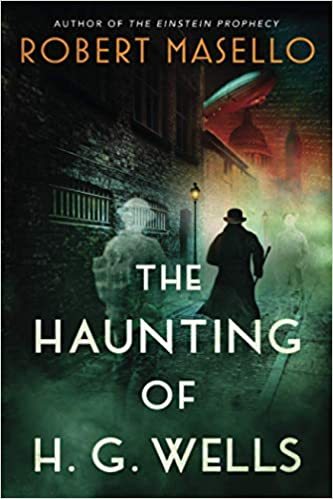
The first book I chose this month was The Haunting of H.G. Wells by Robert Masello. H.G. Wells, for anyone who doesn't know, was a prolific sci-fi writer in the late 19th century. In The Haunting of H.G. Wells, we see H.G. travel to front lines of the war to report and boost public morale. When H.G. gets separated from his unit and ends up in a mustard gas attack, he begins seeing things he can't explain. These apparitions start telling him that the war isn't just being fought on the frontlines - that there is a dangerous and deadly plot afoot in the heart of London. Can H.G. and his companion (yes, that kind) Rebecca West stop this plot?
This was a three star read for me. It's October appropriate because what's more spooky than ghost soldiers? Besides little kid ghosts . . . eesh. No. The Kindle version comes in at around 393 pages, and it's a fast paced romp through a war torn London in the early 20th century. It draws on well-known myths and lore and uses magical realism and other prominent characters from the time period to weave a tale of intrigue. The main antagonist is written well enough that you are honestly scared of him in a few scenes. The rest of the characters are a bit of a wash. Masello was definitely focused on making the book about H.G. Wells, and darn the fact that he has to write all these other characters, too.
Pick up your copy [ here ]
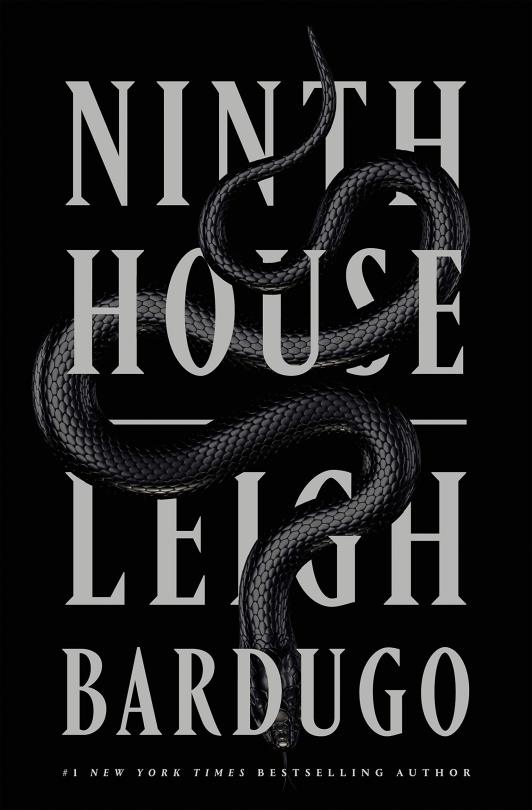
The second book I read in October was Ninth House by Leigh Bardugo. Leigh Bardugo is better known for her Grisha series, which I haven't read yet. Ninth House is not part of this series. It looks like it might be part of its own series and I am HERE FOR THIS.
Ninth House tells the story of Alex Stern, a girl with a tragic past and a dark secret who is recruited to attend Yale by the Dean of the college after she survives a gruesome attack on her and her roommates. The college has nine houses. Eight are devoted to magick and the mystical arts. The ninth, called Lethe, is devoted to policing the other eight houses and making sure that they don't let anything out - or in. Alex is especially suited to this task because ever since she was a little girl, she's been able to see ghosts. When her trainer goes missing and a townie gets murdered on campus, she has to rely on this gift to solve both crimes, against the advice of Lethe house and in a wild race with time and the next moon cycle.
What a perfect book for October - a murder mystery about Yale in the fall! I was going to rate this one three stars - I was entertained but the story wasn't exactly life changing. In 476 Kindle pages, it didn't break my heart or leave me crying in my kitchen floor. The more I thought about it, though, the more I realized it deserves four stars. It's an original story, Alex was relatable to me (she's not to a lot of people but we aren't going to have that conversation today), and I couldn't put it down. I spent 2 hours sitting on a freezing cold beach with a biting wind blowing because I didn't want to put the book down to pack up and go back to the Airbnb. The ending wasn't exactly happy and there was no stupid romance shoved into the story just to be there. Are some things a stretch? Yes. I'm not saying it's a perfect story but I had so much fun reading it! If there is more to the Alex Stern series, I'll probably buy the ebook the day it comes out.
Grab your copy [ here ]

After reading Ninth House, I needed something a little lighter. The Wicked Deep by Shea Ernshaw fit the bill. This was a total cover buy for me. I found it at one of my local used book stores. The wording and design on the cover are iridescent and it was sitting on its shelf shimmering when I decided it needed to come home with me.
The Wicked Deep tells the story of Sparrow, Oregon where three sisters were drowned as witches in the harbor of the little town. Ever since, for a short time each summer they return and steal the bodies of three girls with the aim of luring at least three more boys to their death in the deep, cold water. Penny Talbot has lived in Sparrow all her life and has watched the cycle play out for as long as she can remember. This year, Penny has something to lose. A new boy has just driven into town, and he has no idea what he just walked into.
This was another three star for me, albeit a low three. It was wonderfully YA tropey and was such a perfect read for October, even though it's set in summer. It was a quick, light read coming in at 320 Kindle pages. The author really made you feel for the sisters. To be murdered so violently for a crime they didn't even commit - well, I would absolutely come back and wreak havoc if I could. The ending left a lot to be desired, though, and the twist in the middle was so halfhearted that when it was revealed I just shrugged and kept reading. Overall, it's an easy read if you need a palate cleaner between heavy books and you don't feel like reading Harry Potter again.
Pick up your copy [ here ]
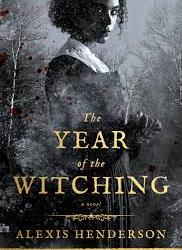
My closer for October is a book that you have no doubt seen on many a BookTube, Bookstagram, Bookblr, and book blog. It's majorly hyped for being a story of a black witch in a Salem-esque town with a religious hierarchy that recalls tales of Mormon polygamy and cult like devotion. It was also supposed to be scary as hell. What better book to read to close out October and celebrate Halloween with?!
The Year of the Witching by Alexis Henderson is about an orphan girl named Immanuelle who lives with her grandparents and cousins in a town called Bethel. After the tragic deaths of her mother and father before she was born, Immanuelle tries hard - very hard - to follow the teachings of the church and to worship the Father. Inside, though, Immanuelle knows that she's different. For starters, she can hear the Darkwood that surrounds Bethel calling her by name and beckoning her inside, which is strictly forbidden by the church. One night on her way home from the market, her ram runs into the forest. Immanuelle has no choice but to follow. In doing so, she starts a chain events that will change the town - and her - forever.
I really wanted to love this book. I wanted it to be a five star read. Witches and religous cults and a creepy forest - it's the perfect recipe to give you chills and enrage you all at the same time. That's not what I got from this one. It was a great concept - a young black witch going to war with a religious sect. I even got excited again writing the blurb up there! The writing fell flat for me. Immanuelle was a great character. Her pain, her conflict, her ostracization just for looking different made her complex and beautiful. The story didn't do her justice.
Ultimately, I gave this one three stars. I finished, I was entertained, and towards the end of the book I didn't want to put it down. According to Goodreads, I devoured all 363 Kindle pages in 4 days. Read it - really, I insist.
Buy it [ here ]
So to recap, I ended up with a historical fiction ghost story, an Ivy league murder mystery, a revenge story including possession, and a historical fiction about a witch. That is as scary as I would like to read, thankyouverymuch!
What did you read in October or how did you celebrate Halloween with social distancing?
0 notes
Text
The Myth and Meaning of MissingNo
A few notes about this essay: first, I have removed the period from the name “MissingNo.” for ease of transcription. I also refer to MissingNo’s sibling as Bar ‘M Bar or [][][][] ‘M [][][][] because its real name is irreproducible in Unicode:

Also, for the purposes of this essay it is helpful to think of Pokémon less as animals and more as a gamut of spectral entities: yokai, devas, fairies, sprites, genies, elemental intelligences, ghosts, servitors, unincorporated astral matter, etc. All those strange and elusive beings who populate world mythology and the collective imagination. In contrast to our world, however, people in Kanto are universally aware of these entities and their relation to ourselves. Much more can be said on this subject, but allow the basic premise to inform your reading when it feels appropriate. The subject before us is liminal by its nature.
Myths, Stories, and Suspicions

When we encounter a glitch in a game the temptation is to say that it broke our immersion. Maybe it’s because children are more easily entranced, but as a child my experience with MissingNo did not feel particularly incongruous with the narrative. The encounter, though strange, didn’t contradict the world of the game -- it expanded it in a psychedelic direction. When I met MissingNo, the battle played out more or less as normal. It was only the image of the creature, the arcane initiation, and the haunting after-effects that were atypical.
As soon as Pokémon Red & Blue came out, one fact of life became very clear: Kids love to spread tall tales about Pokémon. It was quite common to hear about Mew hiding under a truck or Togepi skulking around in the inaccessible wilderness behind Bill’s house. But the purported apparition of something called “MissingNo” or “Bar ‘M Bar” held an especially uncanny sway, because everyone believed it to be true. The basic story was that you talk to an old man, and then fly to an island where you meet bizarre and game-glitching Pokémon – but the many accounts which peppered the playground and Internet each held idiosyncratic details. Some said Mewtwo would turn up on the island, others said they found Pokémon native to the Safari Zone, or rogue trainers, or that you could multiply your items by 100. When I finally initiated what came to be known as the “Old Man Glitch”, I performed it in the prescribed manner:
Talk to the Old Man in the North of Viridian City. He will show you how to catch a Weedle.
As soon as the Old Man is finished, fly to Cinnabar Island.
On the island, walk over to the eastern edge and use Surf.
Surf the very edge of the water, moving up and down.
And sure enough, there appeared a fuzzy Tetris-looking rando named [][][][] ‘M [][][][]. Armed with a little background research, I succeeded in slaying this entity, and came away with 128 rare candies, a glitched out Hall of Fame record, and a whole lot of questions. The experience was so simple and tidy, and the performance of the glitch was just dreamlike enough that my young mind felt the thin silver light of meaning shining dimly from behind the supposedly arbitrary method of contact.

MissingNo and its glitch siblings became well known in the Pokémon community as reliable and functional game exploits, and stuck in the imagination for the peculiarity of their presentation. The programming quirks behind MissingNo’s operations are well understood, and the character has wormed its way into a sizable number of fan theories and creepypastas. Something about this strange little block of static resonates with players, and it seems to have surrounded itself with cryptic clues as to its true nature.
The Method of Contact
The first step to understanding a mysterious aberration in a game is to consider the events that lead up to it. What must the player do in order to find MissingNo? The trip begins by talking to an old man in Viridian City who shows the player how to catch Pokémon by snagging a wild Weedle in a brief scripted encounter. This is an interesting motif right off the bat, because we are meeting a teacher figure who shows us how to catch the worm. In dreams and in myth, the worm is often a symbolic representation of the Kundalini serpent, the principal driving force of life itself which coils at the base of the spine. The Old Man is found near the beginning of the game, and he will show you this tutorial as many times as you like. After all, he is teaching an essential lesson: catch the Pokémon around you to expand your team; or more abstractly: integrate the aspects of nature which complete you.
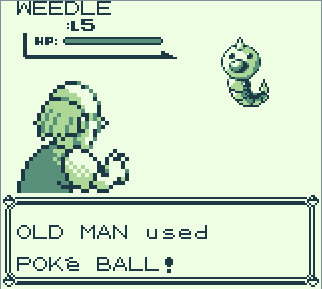
Viridian city itself is a special place, in that we begin and end our Pokémon journey there. It is the first town we come to after leaving home, and it is also host to the final gym and provides a road to the Pokémon League – the culmination of a trainer’s journey.
The next step to MissingNo is to fly to volcanic Cinnabar Island, which is incidentally the last town a trainer discovers. So we have leapt from the site of our first lesson to the final city. Here on Cinnabar we walk straight east to the beach, and use surf to ride a Pokemon up and down the edge of the water. If we venture further out to sea, the ritual is forfeit and we must restart. So we glide up and down and up. Here along the crashing waves, apparitions greet us according to our name. The letters in the player’s name are the values that determine which Pokémon appear – and what form MissingNo takes. With this, contact is made.
So let’s take a look at this setting. The island is a classic symbol of self-conception: a crystallization of identity emergent from the undifferentiated ocean. There happens to be a volcano on this island, which is also a timeless symbol: that of the eruption of unconscious content; hidden energy and power which has formerly lain dormant and unknown. We encounter MissingNo in a rather narrow area: a single column of tiles representing the edge of an island. We move up and down this coast attempting to trigger the event, swimming/surfing/pacing along the seashore. This is an incredibly profound detail, because the shore of the ocean signifies the mediation between the mundane terrestrial (the land) and the vast realm of the unconscious (the ocean). The fact that it is the Eastern coast is a bonus, as that is the place where the sun rises in its most prolonged glow, and gives birth to the new day.
The island itself is named Cinnabar, home to a research facility that serves a major role in the game’s plot. As we discover through research notes littered about, Cinnabar Mansion was the site of a series of experiments to re-create Mew, which is thought to be a primordial Pokémon. Famously, this resulted in the creation of Mewtwo, an anthropomorphic “clone” of Mew who lacks the originator’s genetic purity (Mewtwo cannot learn any TM, as Mew can), but appears to have gained a humanlike awareness, a trait lengthily elaborated in the first Pokémon movie.
Mew as Prima Materia
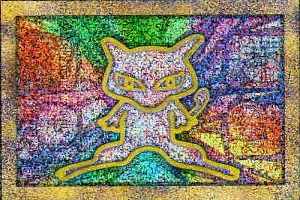
So what does Mew symbolize? It is known to resemble an embryo, and believed to be the ancestor of all other Pokémon. It is a light pink, which is interesting given that the alchemical prima materia – the formless substance that composes the primeval material of the universe – is said to be dually white and red. In the original games it is only attainable through the metatextual experience of an IRL promotional event, and was allegedly inserted into the game secretly. Mew is clearly meant to be a transcendent being, notoriously elusive and often depicted in space.
Mew is the only pokemon that learns Transform, except of course for Ditto. This has spawned a highly popular fan theory that Dittos are failed clones of Mew. There are some supporting reasons for this idea: they share the same coloration (in both common and shiny iterations), the same weight, the same stats, and Ditto is present at locations relevant to Mew’s story (notably the Pokémon Mansion and the Cerulean Cave, where Mewtwo is found). Unlike Mew, which cannot breed in game, Ditto can successfully mate with any non-Legendary Pokémon. But Mew, critically, is a psychic type. Ditto is “normal.” It is as though the scientists succeeded in recreating the prima materia, but only in a purely physicalist sense. Ditto contains the genetic potential of all current life, but it does not generate new forms. It does not even learn new moves by itself, it must be taught. Science has apparently replicated the form and fertility of immemorial cosmic life, but not its potentiating vitality, its breath of life, its pneuma.
I wonder where that pneuma went. Mewtwo, though not having begat novel lifeforms of its own, nevertheless expresses the pneuma in its thoughts and deeds. But maybe pneuma, as a formless concept, could only be expressed allegorically to the player as the enigmatic and varying being known as MissingNo. Revealingly, MissingNo is a Bird/Normal type Pokémon, birds being classical symbols of the spirit. Its cry upon encounter is the default “blank cry”: an unaffected cry of the male Nidoran (the only gendered Pokémon in the original release). But when MissingNo is viewed in the Pokédex, it makes the sound of a Rhydon, the first Pokémon ever designed; we could interpret this therefore as a reference to the voice of creative impulse. There is a caveat to discovering this: the player can only view the Pokedex entry if they have not seen a Cubone. This is another mythic peculiarity, as Cubone’s defining characteristic is its knowledge of loneliness, and its desire for reconciliation with its ancestors. If this sense of separation has never been known, only then can we “read” Missingno’s information, understand its primal utterance, and order it in our Pokédex-pantheon (as #000)

Curiously, Cubone is also host to a popular fan theory: that its missing mother is Kangaskhan. This is believed mainly because Cubone always pines for its perpetually absent mother, and Kangaskhans bear their young in their pouch, but the young are never seen independently. It is therefore supposed that when Kangaskhans die, their young don the skulls of their mothers and become Cubone. I have no strong opinion about this story, but MissingNo closes the circuit thematically. Just as MissingNo has ties to Cubone, its sibling Bar ‘M Bar mysteriously evolves into Kanghaskhan. Additionally, one of the appearances MissingNo can take is the “Ghost” sprite. In the main game, this sprite is only used for the ghost of Cubone’s mother in a unique encounter. Until a special item is used, this ghost isn’t affected by the player; with this guise MissingNo tells us it cannot be grasped.
4 Visions of MissingNo
In addition to the L-shaped white noise and the ghost, MissingNo can appear in two more ways. It can take the form of the fossils glimpsed in the Pewter Museum: a skeleton of Kabutops or a skeleton of Aerodactyl. These constellations of bones further suggest that MissingNo is an ancestral spirit. Kabutops is a water dwelling primordial life-form, whose development name meant “Atlantis,” and who symbolizes the origin of physical life from the first primal waters. Aerodactyl resembles a dragon or wyvern, an intermediary of heaven and earth. These two beasts, like the ghost, are no longer embodied. Though all 3 are potential symbols of the dead, they embody that sentiment differently. Kabutops comes from the water, Aerodactyl from the sky, and the ghost, as a veiled Marowak, would be terrestrial, but its image taken independently refers to the realm of the etheric.

To see these alternative forms, the player must have a certain letter in the 5th, 7th, or 9th slot of their character name: W for Kabutops, X for Aerodactyl, and Y for the ghost. The natural form of MissingNo gives us 4 forms, an apparently timeless property of visionary and mystic experience, from Ezekiel to mandala art and the platonic elements. In fact, there are over 150 such amplifications found in Carl Jung’s General Index, so it’s rather difficult to catch them all. Like many mythological quaternaries, 1 among the 4 is qualitatively exceptional. In this case, of course, that is the so-called “Normal” form, the fuzzy L-block which appears as a result of a much greater variety of player names. Though this natural form is less definite in criteria and appearance, it is actually more definite in its character. The other three forms take their base stats and moves from the last Pokémon in the party (a dittolike effect!); and their sprites, when viewed from the back, are taken from whichever Pokémon’s data was most recently accessed. So when these entities are in use by the player, they resemble something else entirely; they are phenomenologically reordered to resemble a known quantity. The natural form however, has a constant square-shaped sprite when viewed from the back. Though this form is exceptional among the 4, it is reductive to say that this is its “true” image: each of the 4 is a different capitulation of the same idea which itself is formless. Though there is one more peculiarity about the natural form!
MissingNo. and Its Twin
MissingNo’s natural form is identical with Bar ‘M Bar, as is its Pokédex number, leading many to believe that they were the same creature. However, there are many differences between them. Their height, weight, and stats are different, and they learn slightly different moves. Bar ‘M Bar does not cry like a male Nidoran, but instead sings a pitched-up version of the Zapdos call. This sound resembles birdsong with a background buzz indicating electricity. This pitch-shifted voice tells us that Bar M’ Bar resides even higher in the heavens than the sky-streaking legendary bird of thunder. Its “height” is also coincidentally tied in value with that of Rayquaza, a sacred serpent whose name means “firmament” and is the canonical lord of the skies.
Another difference previously mentioned is Bar ‘M Bar’s unique ability to evolve into Kangaskhan. This happens at level 0, but if you glitch it to level 128, it can also evolve into Clefairy. Clefairy is a symbolically rich Pokémon as well; it was the main character of the original manga, and originally slated to be the main character of the anime. It is strongly indicated to be of extraterrestrial origin and is also plainly representative of the fairy kingdom, as indicated by its name and type. Additionally, it happens to be the Pokémon that Bill, a famous internet architect, accidentally transforms into as he is playing with time and space in order to construct a teleporter. We therefore can surmise that Clefairy relates to that which is alien: the alienation of the creature from the franchise, the alien origin of the species within the narrative, and the truly alien experience of inhabiting another body. This changing of bodies is perhaps what Bar ‘M Bar does when pushed past the realm of possibility, into level 128. There is of course a practical programming reason for the number 128, but it also happens to be double the number of possible codons in DNA. The “clef” in Clefairy means “musical key,” or in French simply “key.” Clefairy’s trademark move is metronome, which replicates most other Pokémon moves through the magic of synchronization. What would the world be like if this memetic sprite succeeded in its role as mascot of Pokémon? Would the world be all the more entranced?
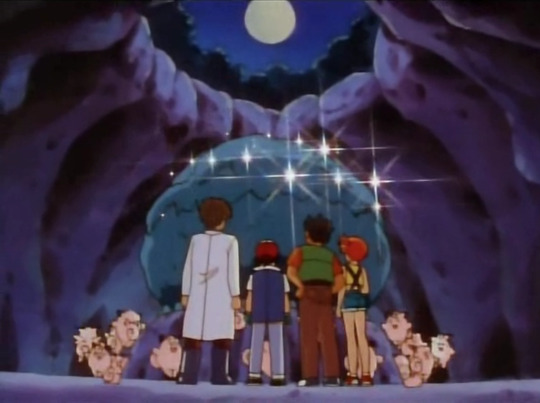
When it comes to seeking an audience, Bar ‘M Bar is even wider in its accommodation than its sibling MissingNo. It can be encountered with any name at all – besides the preset options! Bar ‘M Bar’s own actual name, [][][][]M’[][][][] is certainly its most obvious difference. The bars on either side of the ‘M are determined by the actions of the player – Bulbapedia sums it up nicely:
It is most commonly known as 'M, since these are the only typographical characters in its name—its real name is impossible to produce with text, and some tiles in its name are not constant. It is also called 'M Block due to either the glitchy blocks next to its name or the Pokémon's boxy shape.
The first two tiles in [][][][] ‘M [][][][][]'s name depend on which sprite is occupying the spot where the player's Pokémon appears. In battle, the tiles on the left of its name will copy part of the sprite in the bottom-left corner of the screen (the player's Pokémon), while the block on the right will copy part of the sprite in the upper-right corner of the screen (the opponent's Pokémon). Out of battle, the blocks in its name will change depending on the player's location.
We know that MissingNo’s name is constant, and its form is undefined, a result of the player’s bestowed name. On the other hand, Bar ‘M Bar is a definite outcome for any bestowed name, but its own name is defined by the player! Yet it always retains the ‘M in the middle, which is tempting to interpret as the conjunction n’ (and). It looks as though Bar ‘M Bar’s name is something like “This n’ That.” And indeed, that’s what the sprites which comprise the bars draw from: the player’s Pokémon and the opponent’s Pokémon. The fact that these two glitchy blocks are separated by something close to “and” is a beautiful detail. It takes these two oppositional beings and phrases them both, but does so with the separation intact. If it lacked the ‘M between the two samples it would give a different impression. It is the difference between hendiadys (good and ready) and a modified adjective (well ready). It acknowledges that the two things are distinct and in concert, yet they are termed by Bar ‘M Bar in a single body. There is an endless mystery surrounding the mythological motif of 2-in-1, but it is often explored in alchemy and Jungian psychology through the image of the coniunctio, the holy marriage, the reconciliation of opposites.
Can we even say that Bar ‘M Bar is a single entity? It certainly has the strong dual aspect of its twin, MissingNo. Are these two glitch Pokémon the same or not? In the coding of the game, they are not. None of MissingNo’s forms share the constitution of Bar ‘M Bar. Yet they are defined in the Pokédex – the pantheon of the player’s understanding – in the same place, #000, and therein utter the same cry (Rhydon’s). They share an identical sprite and learn nearly identical moves. They cause the same glitch effects to occur in game. The strongest evidence for seeing them as representations of the same essence is in popular conception: Bar ‘M Bar is frequently referred to as MissingNo, and was the first of many other glitch Pokémon subsumed under the generic description of “MissingNo.” It is almost technical trivia to separate them. And most tellingly for the sake of this investigation, they complete each other’s symbolism. So, they are discrete entities AND they aren’t. The mystery of the coniunctio is thus further embodied in this dual being.
The Lingering Presence
Now that we’ve outlined the taxonomy of MissingNo+, we can begin to look at the consequences. The two most well-known effects of meeting MissingNo are the Item Duplication Glitch and the Hall of Fame glitch. Item duplication occurs after any encounter with MissingNo or Bar ‘M Bar, regardless of whether the player has fled, caught the creature, or knocked it out. When examining the bag after the battle, the player will find that the 6th item in their inventory has been increased by 128 (although this does not occur if the value is already over 128). Given that a player can reorder their inventory at will, this was a famous exploit for getting hundreds of Rare Candies in order to quickly max out any Pokémon’s level, or generating 128 Master Balls ensuring the capture of any creature you meet from then on. Indeed, this is the most common reason for performing the old man glitch, and likely the critical factor in MissingNo’s renown. And what fuel for the legend: a bizarre seaside vision that grants a wish. Another popular exploit is duplicated fossils, normally given only once per game, so that you could resurrect 100 Kabuto, Omanyte, or Aerodactyl. But any item is fair game: you could effectively wish for infinite wealth, health, lives, moves, defense, speed, power, whatever. You hooked the magic fish, what you do with it is up to you.
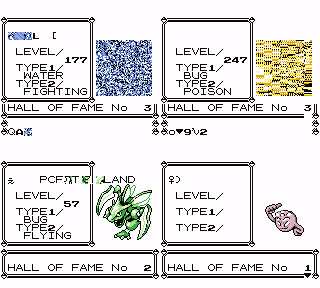
The experience also corrupts your Hall of Fame data, replacing some of the images with blocks of static, and scrambling names and values of your champion Pokémon. This is a largely inconsequential effect, but it has symbolic weight. Each Pokémon that exists is a symbol of some kind, representing an attitude, or an attribute, and as you go along meeting them and incorporating them into yourself, they accumulate further personal meanings. So consciously or unconsciously, the Pokémon that accompany you to your final battle are in some sense a mirror of the player: they represent your priorities, values, and appreciations. These are the ones canonized by the game in the Hall of Fame. MissingNo then transforms this composite irreparably. This act can be seen a psychic realignment of the player-character.
Summary
Let’s imagine the story of meeting MissingNo as a fairly tale. The protagonist, Red, talks to an Old Man at the edge of town who shows him how to catch a worm. Next, Red flies through the skies to a volcanic island. There on the Eastern shore of the island, he swims the coast. Attracted by his name, some number of foreign beasts appear before him, culminating in the appearance of a totally unexpected entity which defies easy categorization (though there are partial physical descriptions in some versions of the story). He then defeats, captures, or flees from the apparition. Then looking in his bag, he finds some object or capacity of his has been magnified to a superhuman extent. Finally, we find that some of his major psychic precepts have been mysteriously and radically altered for evermore.
So what then what was the encounter? An alien? A deity or holy ghost? The pneuma which animates life? Is it an unconscious complex made manifest? A psychotic break? The disorienting eruption of the Real? Is it a highly coherent and synchronous glitch-experience, or a pareidoliac imprint in static? I don’t believe that any of these answers satisfy in themselves. Like the images of MissingNo, the interpretations are interdependent, forming points along the circumference of a subject whose middle cannot be approached by the intellect. What is easier to parse is the influence of MissingNo on the fanbase. MissingNo is so famous as a glitch that it has become the common shorthand for any glitch Pokémon throughout the series. MissingNo and Bar ‘M Bar have inspired not only countless tall tales, but tons of fiction, fanart, merch, and a featured article on Bulbapedia. Using our imagination, it is rather easy to place MissingNo into the narrative context of the game, conceptualizing it any of the above ways. As much as this being seems keen to disrupt our in-game immersion, it seems equally willing to stride across our imagination, as though it were walking a bridge leading into the world of Pokémon, or our own reality, or wherever its place of origin.
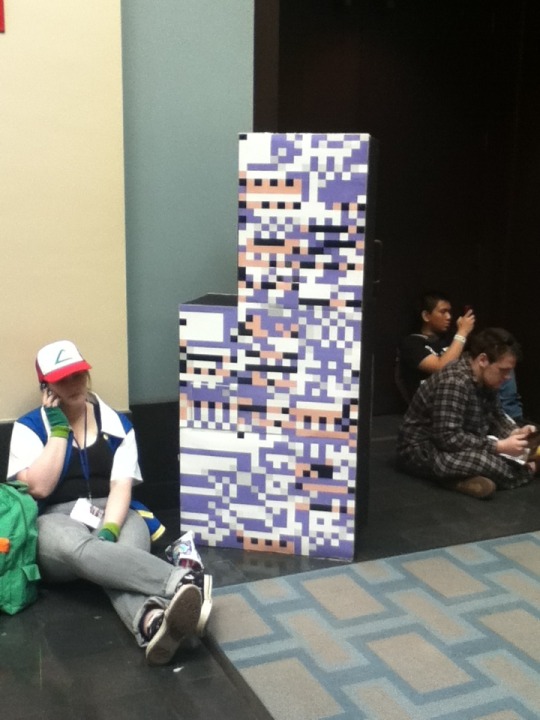
#pokemon#pokemon rgb#pokemon gen 1#missingno#glitch pokemon#pokemon psychology#alchemy#prima materia#pneuma#old man glitch#pokemon myth#pokemon creepypasta#creepypasta#spooky#pokemon theory#mew
315 notes
·
View notes